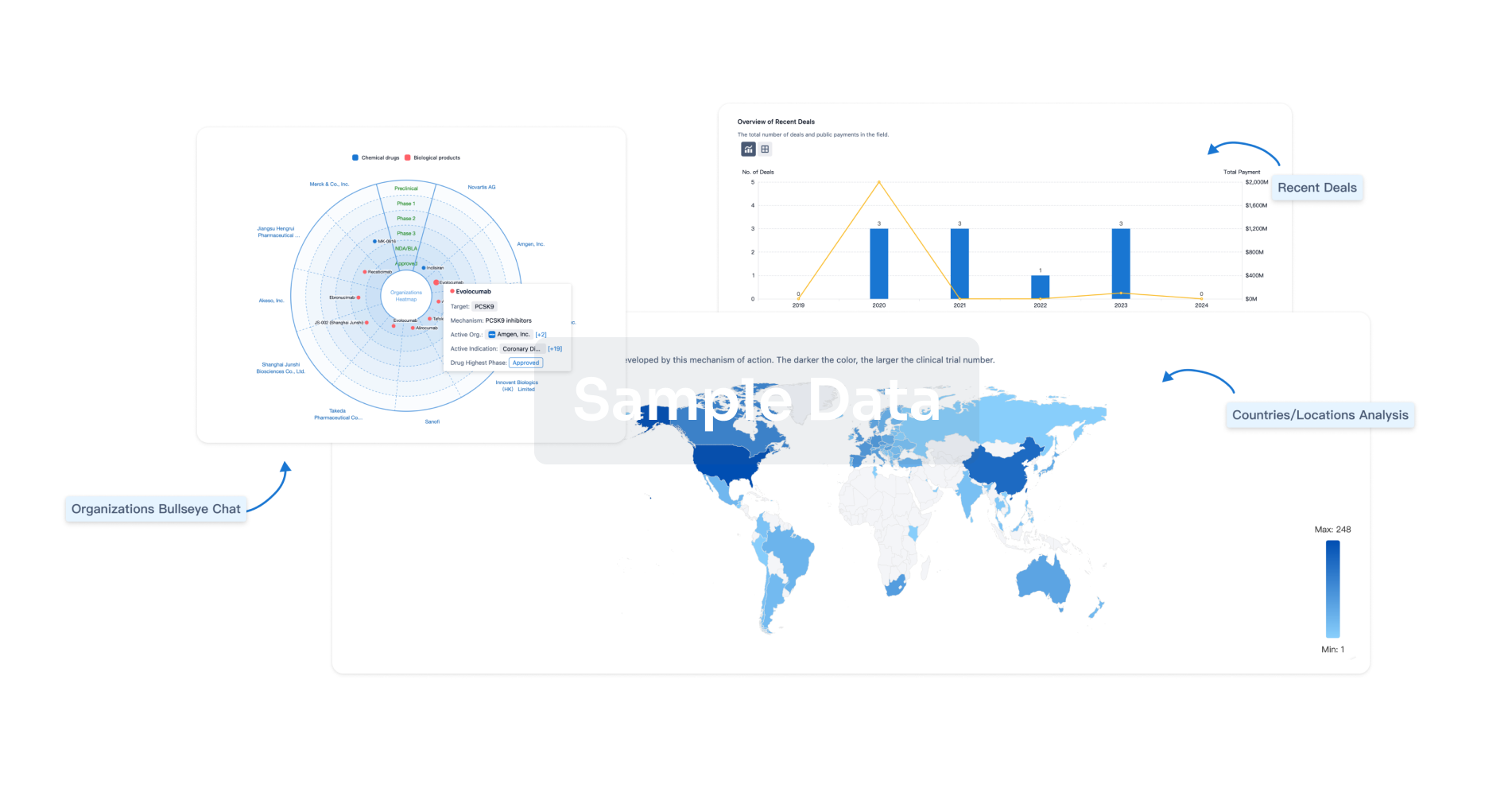Request Demo
Last update 20 Oct 2025
FXN
Last update 20 Oct 2025
Basic Info
Related Targets |
Related
18
Drugs associated with FXNTarget |
Mechanism Frataxin, mitochondrial replacements |
Active Org. |
Originator Org. |
Active Indication |
Inactive Indication- |
Drug Highest PhasePhase 2 |
First Approval Ctry. / Loc.- |
First Approval Date- |
Target |
Mechanism FXN modulators |
Active Org. |
Originator Org. |
Active Indication |
Inactive Indication- |
Drug Highest PhasePhase 1/2 |
First Approval Ctry. / Loc.- |
First Approval Date- |
Target |
Mechanism FXN modulators |
Active Org. |
Originator Org. |
Active Indication |
Inactive Indication- |
Drug Highest PhasePhase 1/2 |
First Approval Ctry. / Loc.- |
First Approval Date- |
13
Clinical Trials associated with FXNNCT07180355
A Phase 1b First-in-Human, Open-Label, Dose-Finding Trial to Evaluate the Safety and Tolerability of SGT-212 Delivered Via Dual Intradentate Nucleus (IDN) and Intravenous (IV) Administration to Participants With Friedreich's Ataxia (FA)
The purpose of this study is to evaluate the safety and tolerability of SGT-212 in participants with Friedreich's ataxia (FA).This is a phase 1b, first in-human, open-label, dose-finding study investigating the safety and tolerability of SGT-212. It will be delivered via dual intradentate nucleus (IDN) and intravenous (IV) administration to participants with FA.
All participants will receive SGT-212 and will be enrolled in the study for approximately 5 years.
All participants will receive SGT-212 and will be enrolled in the study for approximately 5 years.
Start Date01 Oct 2025 |
Sponsor / Collaborator |
NCT06874010
A Phase 1/2, Open-Label, Multiple Ascending Dose Study to Assess the Safety, Tolerability, and Pharmacokinetics of Subcutaneous and Intravenous DT-216P2 in Patients With Friedreich's Ataxia
The purpose of this study is to evaluate the safety and tolerability, and pharmacokinetics of DT-216P2 administered multiple ascending doses in patients with FA.
Start Date01 Jun 2025 |
Sponsor / Collaborator |
NCT06772870
A Phase 1, Double-Masked, Randomized, Placebo-Controlled, Single Ascending Dose Crossover Study to Assess the Safety, Tolerability, and Pharmacokinetics of Subcutaneous and Intravenous DT-216P2 in Normal Healthy Participants
This purpose of the study is to evaluate the safety, tolerability and pharmacokinetics of single ascending doses of DT-216P2 administered either subcutaneously (SC) and intravenously (IV) in normal healthy participants. Approximately 36 participants will be enrolled into this study.
Start Date01 Feb 2025 |
Sponsor / Collaborator |
100 Clinical Results associated with FXN
Login to view more data
100 Translational Medicine associated with FXN
Login to view more data
0 Patents (Medical) associated with FXN
Login to view more data
4,091
Literatures (Medical) associated with FXN01 Jan 2026·ANNALS OF ANATOMY-ANATOMISCHER ANZEIGER
Anatomy reimagined: The landfald classification as a transformative surgical and radiological guide to facial artery variants
Review
Author: Labetowicz, Piotr ; Coleman, John ; Siva Kumar, Yaashmithaa Ap ; Adamek, Jakub ; Landfald, Ingrid C ; Olewnik, Łukasz
The facial artery (FA) is the main vascular supply to the anterior face, but it exhibits considerable anatomical variation that impacts surgical planning. We review FA anatomy and variants, examining clinical and radiological data since 2010, and introduce the updated Landfald Classification of FA variants. The common linguofacial trunk (LFT), in which the facial and lingual arteries arise as a single trunk, is the most prevalent variant (approximately 15 % of cases) (Herrera-Núñez et al., 2020; Triantafyllou et al., 2024). Rare variants include the thyrolinguofacial trunk (TLFT, <3 %) and true arterial duplication or early termination (on the order of a few percent) (Zaccheo et al., 2023; Yoon et al., 2024). These anomalies disrupt the usual FA territory and can increase the risk of tongue or facial ischemia during head and neck surgery, free flap failure, or inadvertent vascular occlusion in cosmetic injections. High-resolution angiographic imaging is essential: computed tomography angiography (CTA) and magnetic resonance angiography (MRA) reliably delineate FA course and branches, though CTA involves ionizing radiation (Furukawa et al., 2013). We present an enhanced Landfald Classification with five major types (I-V) and fourteen subtypes (Ia-Vb) that stratify FA anatomy by branching pattern, clinical implications, and imaging detectability. This framework supports tailored surgical approaches and risk mitigation. For example, classical ("Type I") FA patterns allow predictable flap design, whereas hypoplastic or aberrant ("Type IV-V") variants often necessitate alternative strategies. Surgeons and radiologists should apply detailed preoperative mapping - including CTA, MRA, Doppler ultrasonography, or augmented-reality simulations - to identify FA variants and plan safe dissections. In conclusion, recognizing the full spectrum of FA variation and using the Landfald classification can improve surgical precision and patient safety in reconstructive, oncologic, and aesthetic facial procedures.
31 Dec 2025·REDOX REPORT
Therapeutic combination of L-ascorbic acid, N-acetylcysteine, and dimethyl fumarate in Friedreich’s ataxia: insights from in vitro models
Article
Author: Ge, Haobo ; Ramchunder, Zenouska ; Valle Gómez, Adamo ; Marobbio, Carlo Marya Thomas ; Virmouni, Sara Anjomani ; Pourzand, Charareh ; Edzeamey, Fred Jonathan
Friedreich's Ataxia (FRDA) is a rare neurological disorder caused by an abnormal expansion of Guanine-Adenine-Adenine (GAA) repeat in intron 1 of the FXN gene, which encodes frataxin, leading to reduced expression of frataxin, a mitochondrial protein essential for cellular homeostasis. Frataxin deficiency results in oxidative stress and mitochondrial dysfunction and impaired redox balance. Currently, there is no cure for FRDA. This study aimed to evaluate the therapeutic potential of antioxidants dimethyl fumarate (DMF), N-acetylcysteine (NAC), and L-ascorbic acid (LAA) in restoring mitochondrial redox homeostasis and frataxin levels in FRDA patient-derived fibroblasts and 2D sensory neurons. We assessed cell viability, mitochondrial and cellular reactive oxygen species (ROS) levels, mitochondrial DNA copy number, mitochondrial membrane potential, and frataxin and NRF2 expression at both mRNA and protein levels following antioxidant treatment, either individually or in combination. Treatment with LAA, NAC, and DMF resulted in significant reductions in mitochondrial and cellular ROS, along with increased FXN and NRF2 expression, and enhanced NRF2 nuclear translocation. Furthermore, these compounds improved aconitase/citrate synthase activity, GSH/GSSG ratios, and mitochondrial membrane potential. Notably, the combination of LAA and NAC consistently alleviated multiple disease-associated defects in FRDA cells, suggesting its potential as a promising therapeutic approach.
01 Nov 2025·WATER RESEARCH
Ligand-selective complexation of natural organic matter with Mg2+ modulates nanoplastic transport in seawater-saturated porous media
Article
Author: Hou, Yuanzhang ; Luo, Changjian ; Xiong, Cun ; Qiu, Yuping
Understanding how the intricate components of marine environments govern the transport of nanoplastics (NPs) is crucial, as this directly influences their distribution and ecosystem exposure risk. While extensive research has been conducted on natural organic matter (NOM)-regulated micro-interfacial processes of NPs in marine environments, the synergistic effect of divalent cations, particularly magnesium ion (Mg2+), remains underappreciated. This study elucidates how ligand-specific NOM-Mg2+ complexation significantly influences the transport behavior of NPs in seawater. In 35 PSU seawater, humic acid (HA) and fulvic acid (FA) increased NP surface charge, achieving ζ-potentials of -25.46 mV and -19.58 mV, as compared to -18.00 mV for pristine particles. These macromolecules maintained colloidal stability with hydrodynamic diameters (dDLS) around 600 nm and enhanced mobility, elevating the mass percentages of effluent (Meff) from 26.5% to 43.9% and 35.4%, respectively. In contrast, tannic acid (TA) reduced ζ-potential to -10.33 mV, triggering severe aggregation with a dDLS of 919 nm and diminished mobility, reducing Meff of 7.28%. Removing Mg2+ mitigated HA/FA-mediated mobility enhancements, decreasing Meff to 29.7% and 35.6%, and restored TA-induced mobility suppression, bringing Meff back to 28.0%, confirming the significance role of NOM-Mg2+ interactions. Concentration-dependent experiments indicated that HA/FA-enhanced mobility correlated with Mg2+ and NOM levels, whereas TA-induced suppression was solely dependent on Mg2+ levels, emphasizing the more pronounced impact of TA-Mg2+ complexes. Mechanistically, weak binding of Mg2+ to high-molecular-weight HA (112 kDa) and FA (79 kDa), with constants KM = 0.289 and 0.697, contributed to partial charge neutralization and steric hindrance. Conversely, low-molecular-weight TA (1.9 kDa) formed strong catechol-Mg2+ bridges (KM = 3.746), inducing charge-neutral aggregates. Two-dimensional correlation Fourier-transform infrared spectroscopy (2D-COS-FTIR) and solid-state 13C nuclear magnetic resonance (NMR) analyses identified carboxyl/phenolic groups in HA/FA and ortho-polyphenols in TA as primary Mg2+ binding sites, indicating that structural differences among various NOM results in distinct ligand selectivity in their interactions with Mg2+. Molecular dynamics simulations illustrated TA-Mg2+ bridging dynamically induced large NP aggregates within 20 nanoseconds. These findings highlight the importance of ligand-selective NOM-Mg2+ complexation as a critical regulator of NP fate in marine ecosystems.
135
News (Medical) associated with FXN08 Oct 2025
U.S. Food and Drug Administration (FDA) open to pooling data from ongoing Phase I/II studies of LX2006 with pivotal data to support a Biologics License Application (BLA) for Accelerated Approval
Interim clinical data show sustained or deepening improvements in the majority of participants across both cardiac and neurologic measures of Friedreich ataxia
Participants with abnormal left ventricular mass index (LVMI) at baseline achieved 18% mean reduction in LVMI at 6 months and 23% mean reduction at 12 months, exceeding FDA-aligned target threshold of 10% reduction
Clinically meaningful improvement observed in the modified Friedreich Ataxia Rating Scale (mFARS), indicative of slowed disease progression and improved function
Company to host webcast today at 8:00 AM ET
Oct. 07, 2025 -- Lexeo Therapeutics, Inc. (Nasdaq: LXEO), a clinical stage genetic medicine company dedicated to pioneering novel treatments for cardiovascular diseases, today announced updates to key components of an Accelerated Approval pathway for LX2006 in Friedreich ataxia (FA) cardiomyopathy, alongside new interim clinical data from ongoing Phase I/II studies.
“We are encouraged by our recent dialogue with the FDA on LX2006, and we appreciate the Agency’s collaborative spirit as we work to deliver a potentially life-changing therapy to the FA community as efficiently as possible,” said R. Nolan Townsend, Chief Executive Officer of Lexeo Therapeutics. “Given the highly compelling data to date that demonstrate clinically meaningful improvements across both cardiac and neurologic measures of FA, we are now pursuing a development strategy that could enable a smaller pivotal study, given the potential to pool data with the ongoing Phase I/II trials, as well as potentially assessing the co-primary endpoint of LVMI earlier than 12 months. This approach could accelerate our overall timeline toward a BLA submission for LX2006 under the Accelerated Approval pathway.”
In response to questions from the Company regarding the possibility of a faster path to a BLA, the FDA has indicated openness to a BLA submission for accelerated approval that includes clinical data from the ongoing Phase I/II studies of LX2006 pooled with new clinical data to be generated in the planned pivotal study. To enable pooling of these data to support licensure, Lexeo will submit enhanced manufacturing comparability data and meet an additional nonclinical requirement prior to the initiation of the planned pivotal study, given the Company’s intention to leverage its optimized, high-yield Sf9-baculovirus manufacturing platform for future clinical and commercial drug supply, compared to the adherent HEK293 process used for Phase I/II clinical supply. The FDA also previously agreed to evaluate the co-primary endpoint of LVMI at a time point earlier than 12 months. Lexeo continues to engage with the FDA on the pivotal protocol and comparability. In discussions to date, there have been no changes to the previously disclosed alignment with the FDA on key parameters related to the LX2006 planned registrational study.
Collectively, Lexeo believes this regulatory feedback has the potential to reduce the size and length of the planned pivotal study, possibly accelerating the overall timeline to BLA submission. Lexeo plans to initiate the LX2006 pivotal study as soon as possible in the first half of 2026, pending finalization of the trial protocol. FDA has previously granted Breakthrough Therapy, Regenerative Medicine Advanced Therapy (RMAT), Orphan Drug and Fast Track designations to LX2006, and admitted LX2006 into the CMC Development and Readiness Pilot (CDRP) program.
Updated interim clinical data from both ongoing Phase I/II studies of LX2006 continue to show encouraging safety and efficacy, exceeding the thresholds previously agreed with FDA for co-primary endpoints LVMI and frataxin expression.
Left ventricular mass index (LVMI):
Among participants with abnormal baseline LVMI (key inclusion criteria for pivotal study; n=6):
6 of 6 participants achieved LVMI measurements within the normal range as of latest visit
5 of 6 participants achieved >10% improvement by 12 months
18% mean improvement in LVMI at 6 months and 23% mean improvement at 12 months, exceeding 10% FDA-aligned threshold for pivotal study
28% mean improvement in LVMI at 6 months and 33% mean improvement at 12 months in mid- and high-dose cohorts (n=3), suggesting dose-dependent improvement
Among participants with normal baseline LVMI (n=10), the majority demonstrated LVMI improvement or stabilization over time
Secondary cardiac biomarkers:
14 of 16 participants achieved >25% reduction in high-sensitivity troponin I from baseline at latest visit
14 of 16 participants achieved reduction or stabilization in lateral wall thickness (LWT) from baseline at latest visit
Modified Friedreich Ataxia Rating Scale (mFARS):
2.0-point mean improvement from baseline at latest visit across all participants with >6-months of follow-up (n=16)
11 of 16 participants achieved reduction or stabilization in mFARS from baseline at latest visit
Previously reported data from Lexeo’s ongoing SUNRISE-FA trial (n=8) showed that all study participants achieved increases in frataxin protein expression from baseline at 3 months, with dose-dependent increases observed across cohorts.
Treatment with LX2006 has been generally well tolerated with no Grade 3+ SAEs to date
No clinically significant complement activation
Minimal, transient liver function test (LFT) elevations
No signs of frataxin over-expression observed in cardiac tissue
No participants discontinued from either study
One previously disclosed, possibly treatment-related Grade 2 event of asymptomatic myocarditis observed one year after dosing
Lexeo Therapeutics will host a webcast at 8:00 AM ET today, October 7, 2025. Analysts and investors can participate by accessing the webcast live on the News & Events page in the Investors section of Lexeo’s website, www.lexeotx.com. The webcast will be archived on the company’s website following completion of the call, and presentation materials will be available on the Presentations page of the website.
LX2006 is an AAV-based gene therapy candidate for the treatment of FA cardiomyopathy, the leading cause of death in individuals with FA which affects approximately 5,000 people in the United States. LX2006 is designed to systemically deliver a functional frataxin gene to promote the expression of the frataxin protein and restore mitochondrial function in myocardial cells. LX2006 is being evaluated in two clinical trials, the Lexeo-sponsored SUNRISE-FA Phase 1/2 clinical trial (NCT05445323) and the Weill Cornell Medicine investigator-initiated Phase 1A trial (NCT05302271). LX2006 has been granted Breakthrough Therapy, Regenerative Medicine Advanced Therapy, Orphan Drug, Rare Pediatric Disease and Fast Track designations by the FDA, admitted into the FDA CMC Development and Readiness Pilot (CDRP) program, and granted orphan medicinal product designation by the European Commission.
Lexeo Therapeutics is a New York City-based, clinical stage genetic medicine company dedicated to reshaping heart health by applying pioneering science to fundamentally change how cardiovascular diseases are treated. The Company is advancing a portfolio of therapeutic candidates that take aim at the underlying genetic causes of conditions, including LX2006 in Friedreich ataxia (FA) cardiomyopathy, LX2020 in plakophilin-2 (PKP2) arrhythmogenic cardiomyopathy, and others in devastating diseases with high unmet need.
The content above comes from the network. if any infringement, please contact us to modify.

Clinical ResultFast TrackOrphan DrugBreakthrough Therapy
07 Oct 2025
Lexeo Therapeutics
said
that it could apply for an even earlier accelerated approval of its gene therapy to treat heart muscle disease in people with Friedreich’s ataxia.
The FDA was open to the idea of pooling clinical data from its current Phase 1/2 gene therapy trial with results from its planned pivotal trial, the company said Tuesday. This means that the company could run a smaller pivotal study, Lexeo CEO R. Nolan Townsend said in a statement.
The gene therapy, codenamed LX2006, is being studied to treat Friedreich’s ataxia cardiomyopathy. The FDA previously agreed that one of the primary endpoints, called left ventricular mass index (LVMI), in the pivotal trial could be evaluated earlier than one year. Higher LVMI indicates an abnormal thickening of the heart wall, which means it’s harder for the heart to pump blood.
Lexeo’s shares
$LXEO
jumped 30% at market open Tuesday.
In order for Lexeo to use pooled data, it has to submit manufacturing comparability analysis as well as nonclinical results since its future gene therapy manufacturing process is different compared to the Phase 1/2 study.
On Tuesday, Lexeo also reported updated results from its Phase 1/2 trial, showing that five of six patients saw greater than 10% improvement on LVMI by one year and that all six reached LVMI measures within normal range as of their latest visit.
In 17 participants, it was reported that the gene therapy “has been generally well tolerated” with “minimal, transient” elevations on liver enzyme tests.
The gene therapy is currently being studied in two clinical trials: the Phase 1/2 study sponsored by Lexeo called SUNRISE-FA, as well as an investigator-sponsored Phase 1a study at Weill Cornell Medicine. The biotech plans to start its pivotal trial in the first half of next year.
Friedreich’s ataxia is a rare disease caused by a deficiency in a protein called frataxin, which is needed for the mitochondria to function properly. The disease can lead to problems with movement and balance, as well as heart dysfunction, which is the leading cause of death in people with the rare degenerative condition. Lexeo’s gene therapy uses viral envelopes called AAVs to deliver a functional frataxin gene to heart cells.
Gene TherapyClinical ResultPhase 1Phase 2
30 Sep 2025
iStock,
Nuthawut Somsuk
Despite tolerability concerns, nomlabofusp’s overall efficacy represents a “large win” for Larimar, according to analysts at William Blair, who lauded the therapy’s functional benefits.
Larimar Therapeutics’ investigational frataxin therapy nomlabofusp
significantly improved
functional outcomes in an ongoing open-label study of patients with Friedreich’s ataxia—but safety signals have left investors disappointed. The biotech was down 33% at market close on Monday.
Data reported Monday showed that patients treated with daily nomlabofusp saw a substantial increase in frataxin levels at 6 months, with skin concentrations matching those in asymptomatic carriers. The drug also led to a “consistent directional improvement” in key functional outcomes, including fatigue and activities of daily living, findings that Larimar said suggest a “potential clinical benefit across a broad spectrum of patients” with Friedreich’s ataxia (FA).
Analysts at William Blair appeared to agree, telling investors in a Monday note that the frataxin improvement is “a large win” for nomlabofusp, while its functional benefits “have not been seen in an interventional FA trial to our knowledge.” Taken together, these results paint an “impressive” clinical efficacy pro nomlabofusp, the analysts wrote.
Tolerability results, however, were mixed. In its news release on Monday, Larimar claimed that nomlabofusp was “generally well-tolerated” but revealed that seven of 39 treated patients had experienced anaphylaxis and needed to be pulled from the study. Following these cases, the biotech has decided to modify its starting dose regimen for nomlabofusp, which the FDA has agreed to.
Despite regulatory alignment on the changes, the anaphylaxis episodes “are undoubtedly a concern for investors,” William Blair said on Monday, noting that risks will remain “somewhat unknown” as Larimar moves toward a biologics license application in the second quarter of 2026.
Still, “the unmet need in FA remains high with no disease-modifying therapy currently available, and we still see a path forward for nomlabofusp approval here given impressive efficacy/biomarker data,” the analysts wrote.
Friedreich’s ataxia is a rare mitochondrial disorder that
affects 1 in 50,000 people in the U.S.
The disease is characterized by a deficiency in the frataxin protein, which is crucial for mitochondrial function. Patients with FA experience motor and other movement difficulties, fatigue and problems with speech or swallowing, among other symptoms.
Leading the FA space is Biogen with its Nrf2 agonist Skyclarys, which
won the FDA’s approval in 2023
. The drug has since become a major product for Biogen, bringing in
$382.5 million
worldwide last year.
Also in the FA game is PTC Therapeutics and its small-molecule drug vatiquinone, which inhibits key disease pathways. The drug’s development has been rocky, however. In May 2023, vatiquinone
failed the Phase III MOVE-FA
study when it did not significantly improve disease progression versus placebo. Last month, the FDA
rejected
vatiquinone, noting that “substantial evidence of efficacy was not demonstrated.”
Phase 3Clinical ResultDrug Approval
Analysis
Perform a panoramic analysis of this field.
login
or

AI Agents Built for Biopharma Breakthroughs
Accelerate discovery. Empower decisions. Transform outcomes.
Get started for free today!
Accelerate Strategic R&D decision making with Synapse, PatSnap’s AI-powered Connected Innovation Intelligence Platform Built for Life Sciences Professionals.
Start your data trial now!
Synapse data is also accessible to external entities via APIs or data packages. Empower better decisions with the latest in pharmaceutical intelligence.
Bio
Bio Sequences Search & Analysis
Sign up for free
Chemical
Chemical Structures Search & Analysis
Sign up for free



